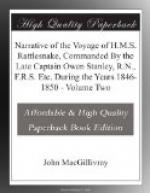Many brush turkeys (Talegalla lathami) were shot by our sportsmen, and scarcely a day passed on which the natives did not procure for us some of their eggs. The mode in which these and other eggs are cooked by the blacks is to roll them up in two or three large leaves, and roast them in the ashes; the eggs burst, of course, but the leaves prevent the contents from escaping. Both bird and eggs are excellent eating; the latter, averaging three and a half inches in length, of a pure white colour, are deposited in low mounds of earth and leaves in the dense brushes in a similar manner to those of the megapodius, and are easily dug out with the hand. I have seen three or four taken out of one mound where they were arranged in a large circle, a foot and a half from the surface. The laying bird carefully effaces any mark she may have made in scooping out a place for the eggs, but the keen eye of a native quickly detects the slightest sign of recent disturbance of the mound, and he seldom fails to hit upon the eggs.
SEASONS.
As at Port Essington, the year at Cape York is divided into two seasons,* the dry and the rainy. From personal observation and other sources of information, it would appear that the limits and duration of these admit of so much variation that it is impossible to determine with certainty, even within a month, when one ceases and the other begins. It would appear however that the dry season, characterised by the prevalence of the south-east trade, usually terminates in November, the change having for some time previous been indicated by calms, light winds, sometimes from the westward, a gloomy unsettled appearance in the weather, and occasional showers—violent squalls of wind and rain are frequent about this time until the westerly breezes set in, when the weather becomes moderate with frequent rain, occasionally very heavy, and intervals, often of many days duration, of dry weather. In the month of March the south-east trade usually resumes its former influence, the change being often attended with the same thick squally weather, and perhaps a gale from the north-west, which ushered in the westerly monsoon.
(Footnote. The natives of the neighbouring Prince of Wales Island distinguish the dry season (aibu or the fine weather) the wet (kuki or the North-West wind which then prevails) and the period of change (malgui) equivalent to our Spring and Autumn.)
WINDS.
Our own experience of the winds during our last stay at Cape York, at the period when the change of the monsoon was to be expected, may be summed up as follows. During the month of October the trade-wind prevailed, keeping pretty steady at East-South-East, and generally blowing rather strongly, with hazy weather and an occasional shower. For three days in the middle of the month we experienced light north-westerly winds dying away again in the evening, and on the 25th a violent squall from the same quarter accompanied by




